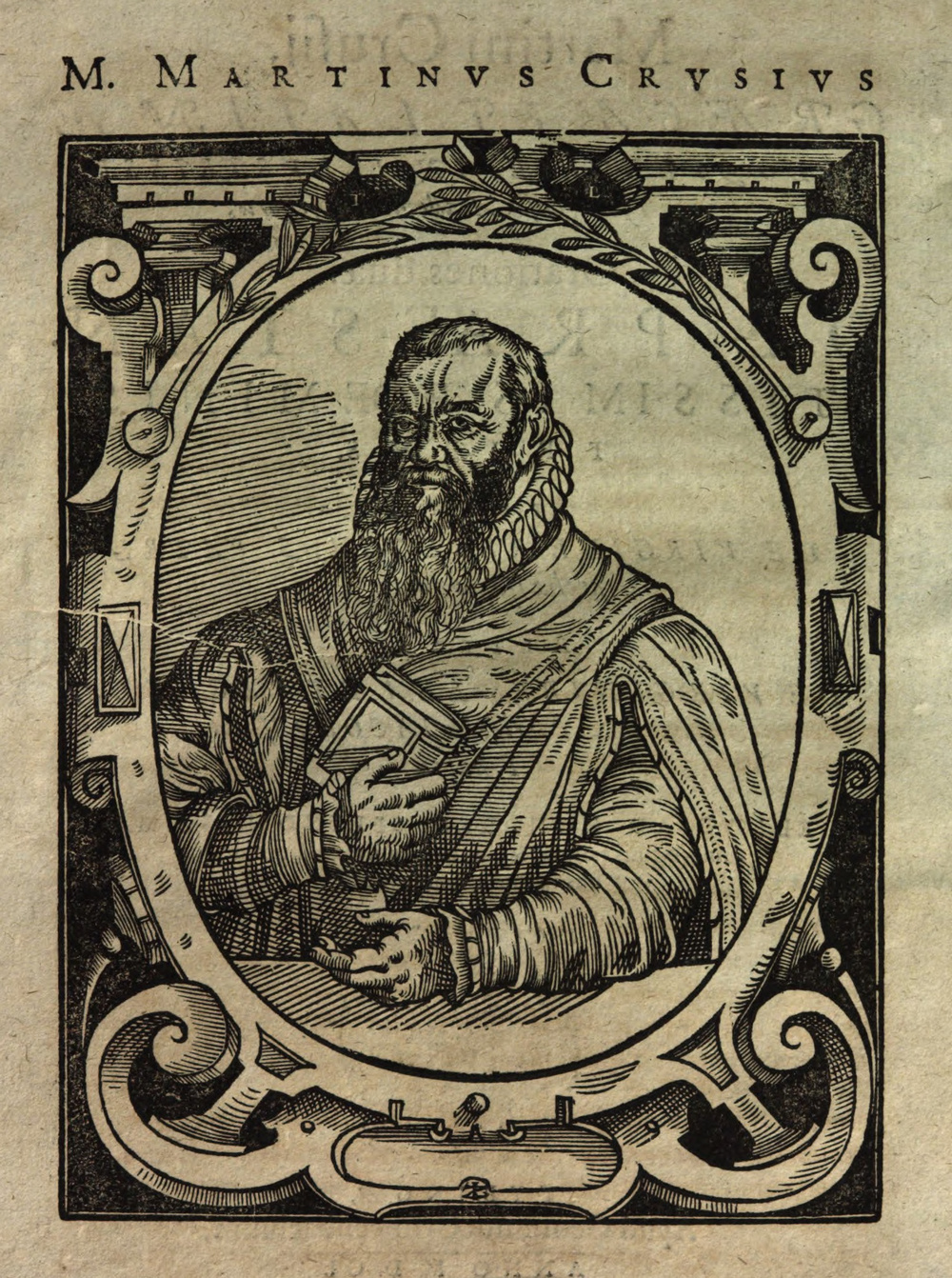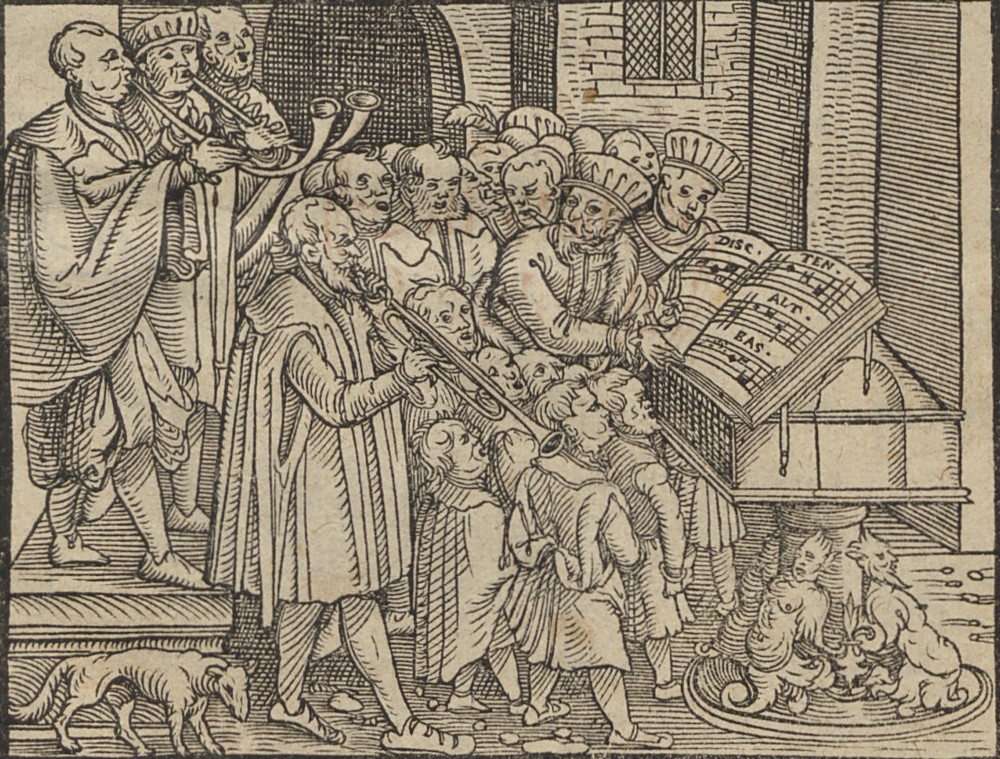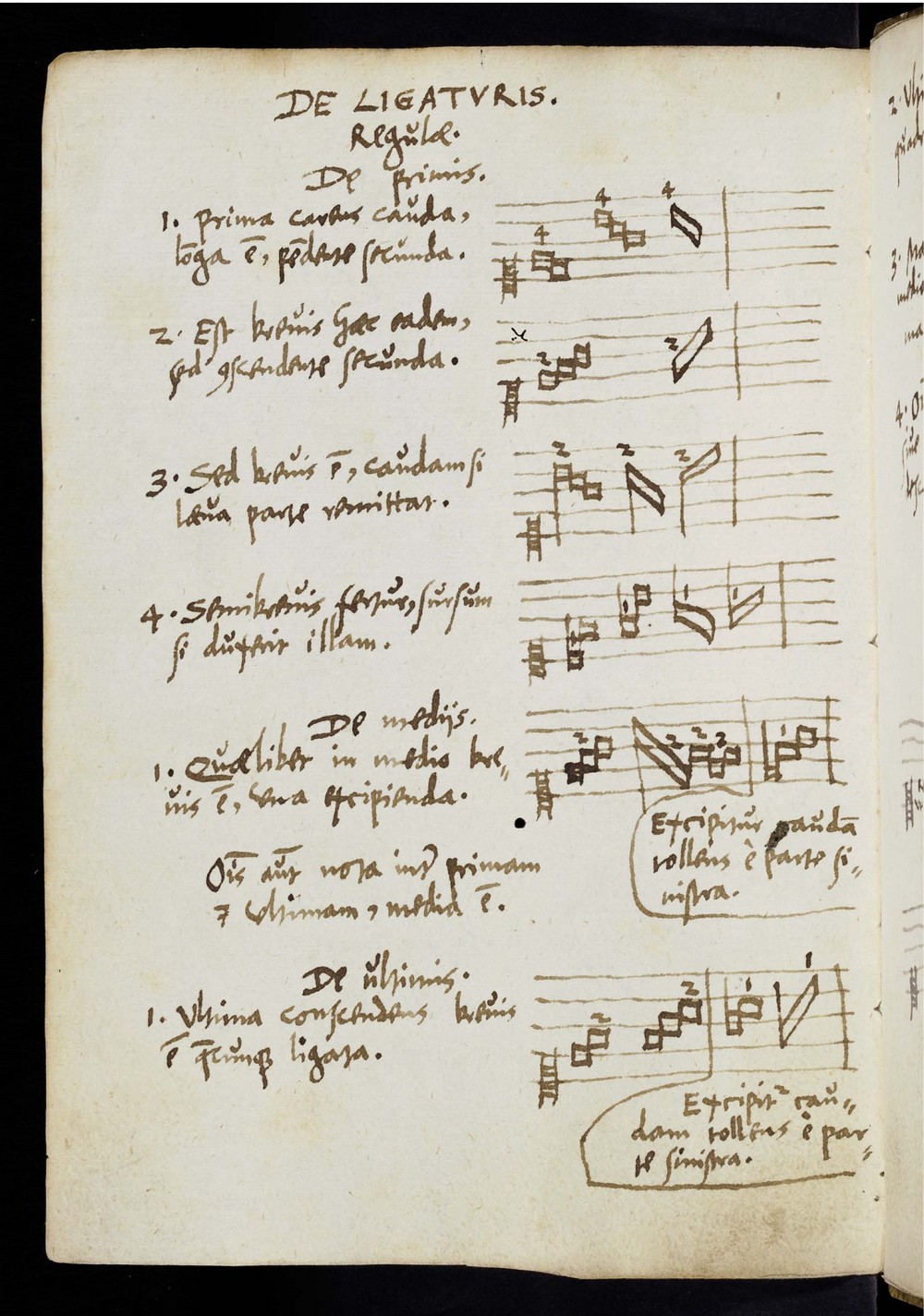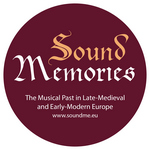Hymny a moteta, paměť a minulost: Hudební praxe v běžném životě německých luteránů v raném novověku
[block background=“#e5e5e5″]For English version of the article please see below.[/block]
Martin Crusius, profesor v Tübigenu, renomovaný historik a specialista na staré Řecko, si celý život vedl deník. Pod datem 27. srpna 1595 najdeme následující seznam (s více než sedmdesáti položkami):
Katalog písní
jež zpívám už mnoho let, zvláště po ranní modlitbě, při oblékání a česání, nebo když jsem unaven studiem. (Všechny je znám nazpaměť a zdobím je.)
- Vnser vatter im Himmelreich, Lutheri.
- Wier glauben all an einen Gott.
- Nun welche hie ier Hoffnung gar.
4. Dies sind die hailigen zehen Gebott - Nunc bitten wier den H. Gaist, μονοφώνος, ut in templo canitur [jednohlasá, jak se zpívá v kostele]
[…]
- In me transierunt.
- Idem, alia compositione. [15]76.
- Susanna videns se rapi: Bassum et Discantum 1589.
- Quemadmodum desiderat cervus. 1559.
- Deus misereatur nostri. Orlandi.”
Dokument je ilustrací toho, jak hudební praxe a zabývání se různým hudebním repertoárem může ovlivnit život raně novověkého Němce, který není profesionálním hudebníkem. Odhlédneme-li čistě od rozsahu, seznam obsahuje několik zajímavých informací o způsobech zacházení s hudbou: Crusius si zpívá po probuzení, nebo aby si odpočinul; obojí je popsáno i v jiných současných pramenech, které doporučují hudbu jako prostředek rekreace nebo radí zpívat ráno a večer duchovní písně. Ve spojení s oblékáním a česáním je hudba pro Crusia součástí jakéhosi hygienického rituálu těla a duše. Za povšimnutí také stojí, že Crusius zná kusy zpaměti a je dokonce schopen zpívat je „s ozdobami“, což naznačuje, že byl dobře vzdělaný amatérský hudebník.
A konečně výběr písní: ten pokrývá různé roviny – oblíbené luteránské hymny z raných časů reformace jsou zmíněny v první části, latinská vícehlasá moteta v ukázce níže (některá dokonce s uvedením hlasů, které Crusius ovládá). Světské písně neuvádí. Zpívá-li si profesor řečtiny v pokročilém věku (Crusius se narodil roku 1526) každé ráno německé a latinské písně, znamená to v roce 1600 výjimku, či normu?
 Bohatství repertoáru, který Crusius zaznamenal, je dozajista výjimečné. Ale způsob, jakým hudbu používá a o jaký repertoár tu jde, zastupuje široce rozšířený model typický pro luteránskou hudební praxi. Můžeme předpokládat, že písně, které Crusius zná, tvoří část jeho identity, která je, jak se zdá, silně ovlivněna raně moderní luteránskou kulturou.
Bohatství repertoáru, který Crusius zaznamenal, je dozajista výjimečné. Ale způsob, jakým hudbu používá a o jaký repertoár tu jde, zastupuje široce rozšířený model typický pro luteránskou hudební praxi. Můžeme předpokládat, že písně, které Crusius zná, tvoří část jeho identity, která je, jak se zdá, silně ovlivněna raně moderní luteránskou kulturou.
Tato kultura, a to je dobře známo, kladla na přední místo praktickou hudbu – děti se ve škole učily německé hymny, latinské zpěvy a polyfonii. Hymny se měly zpívat při bohoslužbách; ve sborech na způsob Kantorei (německá paralela k našim literátským bratrstvům) provozovali polyfonní hudbu i dospělí, kteří vykonávali jiné profese. Hudba byla součástí všeobecného vzdělání, a protože praktická a teoretická výuka hudby byla včleněna do školních osnov ve většině škol, výsledkem byl velký počet hudebně gramotných lidí. Také víme, že tištěné knihy hymnů byly od počátku reformace v Německu oblíbenými a úspěšnými produkty, tiskly se na mnoha místech a ve velkých nákladech. Svým malým formátem a ilustrativními dřevoryty s náboženskými náměty se hodily pro domácí používání, avšak pouhá existence těchto knih ještě neznamená, že byly skutečně užívány.
Během bohoslužby zpívala kongregace pravidelně i hlavní Lutherovy hymny jako Vater unser nebo Wir gläuben all (což jsou německé verze latinských modliteb Otče náš a Věřím v jednoho Boha). Znalost bohoslužebných zpěvů zpaměti mohla být výsledkem této praxe. Ale svědectví, jako je to Crusiovo, o očividně pozitivní roli hudby na něj osobně, přidává hodnotnou informaci: hymny jsou svědomitě praktikovány také v domácím prostředí. To vše dohromady ilustruje, že hymny vytvořily stabilní tradici náboženských kusů. Mohly se zpívat i v polyfonních verzích (Crusius vyjmenovává dokonce čtyřhlasou verzi Wir gläuben all), a tak se rozšiřují možnosti, v nichž se hymny znaly a zapamatovávaly.
 Další položky seznamu, latinská moteta, přidávají rovinu náročnějšího repertoáru, ale i ten je pro roli hudby v dané kultuře reprezentativní. U osmihlasého Deus misereatur uvádí Crusius autora, je jím Orlando di Lasso, který zemřel rok předtím; zastával významnou pozici kapelníka u bavorského dvora a jeho díla byla tiskem rozšířená po celé Evropě.
Další položky seznamu, latinská moteta, přidávají rovinu náročnějšího repertoáru, ale i ten je pro roli hudby v dané kultuře reprezentativní. U osmihlasého Deus misereatur uvádí Crusius autora, je jím Orlando di Lasso, který zemřel rok předtím; zastával významnou pozici kapelníka u bavorského dvora a jeho díla byla tiskem rozšířená po celé Evropě.
Autoři ostatních kusů mohou být identifikováni s velkou pravděpodobností: In me transierunt je také Lassovo zhudebnění (plus další od neznámého autora). Quemadmodum desiderat je z pera Andrease Grunthlera, Crusiova přítele, a Susanna videns bude pravděpodobně latinské kontrafaktum oblíbené písně (chansonu) Susanne ung jour (vydané Lassem už v roce 1560) nebo latinské moteto Jacoba Le Maistre na tentýž text.
Tento repertoár motet nám poskytuje vhled do hudební paměti luteránů 16. století: odpovídá totiž repertoáru známému z jiných pramenů, například z hudebních sbírek tištěných i rukopisných, nebo – což je řidší případ – v dokumentech udávajících konkrétní užití jednotlivých zpěvů.
Téměř současně s Crusiovým seznamem vznikl podobný doklad aktivně používaného repertoáru ve franckém městě Hof na řece Sále v jihovýchodním Německu. V Hofu se reformace prosadila už v roce 1529, místní kostelní řád obsahuje podrobné informace o užití hudby. A gymnázium, založené v roce 1546 markrabětem Albrechtem Alcibiadem, poskytovalo dost hudebníků k jejímu provádění.
V roce 1592 zaznamenal učitel místního gymnázia Enoch Widmann liturgickou praxi ve farním kostele sv. Michaela, jak se ustavila podle nařízení z roku 1529. Jeho rozměrný rukopis byl určen městským úředníkům a příštím učitelům a kantorům. Tento seznam, na rozdíl od Crusiova, dokumentuje praxi institucionální.
Jeden oddíl vyjmenovává kusy zpívané na různé neděle během církevního roku. Také v tomto repertoáru zaujímá Orlando di Lasso se svými motety a Magnificat velmi významné postavení. Crusiův oblíbený Deus misereatur je v Hofu navrhován pro svátek sv. Vavřince. Toto prominentní postavení Lassa můžeme pozorovat v Německu této doby, včetně protestantských území, Crusius tedy není výjimkou. Lassovy skladby byly často zařazovány do spisů jako příklady: další Crusiův oblíbený kus In me transierunt použil v roce 1606 kantor Joachim Burmeister jako příklad ve svém pojednání Musica poetica, kde se snaží neškolenému čtenářstvu na příkladu rétoriky vysvětlit hudební struktury.
Další zajímavý aspekt seznamu repertoáru z Hofu je vědomí historicity užívaných polyfonních zpěvů: nadpis tohoto oddílu nazývá skladby „nejsladší a nejvybranější hudební kusy od největších mistrů, starých i současných.“ Zde je jasně přítomen koncept „starého“ a „nového“ (skladatelé jsou označeni jako „staří“ nebo „současní“), ale také je zdůrazněna kvalita tohoto repertoáru. Repertoár zahrnuje různé dějinné vrstvy a tato kombinace tradice a kvality se zdá být důvodem pro uchování a jeho užívání.
 Mezi vyjmenovanými autory najdeme značné množství moderních italských skladatelů činných v Římě (např. Tomás Luis de Victoria). Netřeba zdůrazňovat, že tu chybí jakýkoli náznak konfesní loajality, pro Němce pozdního 16. století neexistoval pojem „katolický skladatel“ a osobní vyznání tvůrce nepředstavovalo žádný problém.
Mezi vyjmenovanými autory najdeme značné množství moderních italských skladatelů činných v Římě (např. Tomás Luis de Victoria). Netřeba zdůrazňovat, že tu chybí jakýkoli náznak konfesní loajality, pro Němce pozdního 16. století neexistoval pojem „katolický skladatel“ a osobní vyznání tvůrce nepředstavovalo žádný problém.
Zahrnuto je několik skladatelů z vlámsko- a německojazyčných oblastí, a také „raná“ generace luteránského repertoáru – Heinrich Isaac, Ludwig Senfl a Josquin Desprez.
Tito mají důležité místo: skladatelé narození v 15. století jsou zastoupeni 68 kompozicemi, naproti tomu těch od „střední generace“ (jako byli Arcadelt nebo Clemens non Papa) je jenom 30. Od skladatelů narozených po roce 1520 je zde 129 kusů.
Ze skupiny „starších“ je nejčastěji zastoupen Josquin (11), Senfl (11) a Johann Walter (10); ti všichni byli rovněž oblíbeni ve starších pramenech souvisejících s Wittenbergem.
Ve vysvětlivkách k tomuto seznamu kompozic je navrhováno, aby moteto – nemůže-li být provedeno při hlavní bohoslužbě daného dne – bylo zpíváno o nešporách nebo následující neděli nebo v dalším roce. Důvod je jasně vyjádřen: „Aby dílo velkého mistra nezmizelo, ani nebyla skryta jeho památka, a to, co bylo předkládáno v Božím domě našimi předky, by nemělo být odebráno jejich následovníky kvůli nedbalosti, novinkám nebo zanícenému opovržení vůči starému.“
Enoch Widmann a osoby zodpovědné za hudbu v Hofu chtěli očividně aktivně kultivovat tradici církevní hudby v době dobře etablovaného luteránského kontextu. Ve výsledku si můžeme alespoň představit, že farníci v Hofu (od nichž se nám nedochovala osobní svědectví) byli obeznámeni se širokým spektrem polyfonního repertoáru a cenili si tohoto odkazu. Tyto faktory určitě pomohly zajistit hudbě čestné místo ve společnosti a motivovat autority, aby financovaly a podporovaly potřebné struktury.
Konečně Crusiův případ, jeho hudební horizont, je také užitečný, hledáme-li odpověď na jinou otázku: totiž jakou roli hrála hudba v konkrétním životě historické osoby. Obecní historikové se čím dál častěji zabývají problémem smyslové zkušenosti v historickém kontextu – buď ve snaze přiblížit se životu lidí v minulosti, nebo aby narýsovali ucelenější obraz historie, nesoustředěný jen na elity a mimořádné události, ale beroucí v úvahu každodennost „normálních“ lidí s jejich zkušenostmi a mentalitami.
S tím se také často pokládá otázka po historickém „soundscape“ – rekonstrukci sonického prostředí se všemi součástmi, od hluku po hudbu. Hudba představuje pro taková bádání zvláštní problém, protože jako akustický fenomén nezanechává materiální stopy (jako malířství), a navíc dochované historické dokumenty jsou bohužel často velmi vágní v popisech hudebních aktivit: známe peněžní odměnu, ale ne už kus, jaký zpíval; zaznamenána je váha olova použitého na opravu varhan, ale nástroj sám se nezachoval. Co se týká hudebních pramenů, not, ty bývají nacházeny jinde, než se používaly, anebo neznáme lidi, kteří z nich provozovali hudbu. Crusius nám umožňuje nahlédnout do hudebního světa člověka minulosti – v tomto případě individua naplněného luteránsky pozitivním postojem k hudbě, ale také upřímného milovníka hudby. Tato informace může být využita pro popis hypotetické „zvukové krajiny“: vidíme profesorovu domácnost v Tübingenu, kde její člen nebo náhodný kolemjdoucí jednoho úterního rána zaslechne – a snad i pozná? – úryvky Lassových motet.
Překlad Dita Hradecká
[block background=“#e5e5e5″]Tento seriál vzniká v rámci evropského projektu HERA Sound Memories: The Musical Past in Late-Medieval and Early-Modern Europe, který řeší mezinárodní tým muzikologů pod vedením Prof. Karla Kügleho (Utrecht) v pěti akademických institucích (Univerzita Utrecht, Univerzita Cambridge, Univerzita Curych, Univerzita Karlova Praha, Polská akademie věd Varšava).
Více informací (včetně audio- a videozáznamů) najdete na webových stránkách projektu Sound Memories.[/block]
Vážení čtenáři, vzhledem k mezinárodnímu složení badatelského týmu mimořádně uveřejňujeme českou i anglickou variantu textu.

Memory and Tradition within the European Music Culture of the Late Middle Ages and the Early Modern Times
Hymns and motets, memory and history: musical practices in the daily life of early modern Lutherans in Germany
Martin Crusius – a Tübigen professor, renowned historian, and Greek scholar – kept a diary during his life. He noted the following list under the date 27 August 1595 (which comprises over 70 items in total):
[**Textauszug vielleicht möglich als kleine Box in der Spalte, oder so?**]
Catalogue of the songs
which I have sung for many years, particularly after morning prayer, between dressing and combing, or after I’m exhausted from study. (And I know them all by heart, and embellish them):
- Vnser vatter im Himmelreich, Lutheri.
- Wier glauben all an einen Gott.
- Nun welche hie ier Hoffnung gar.
4. Dies sind die hailigen zehen Gebott - Nunc bitten wier den H. Gaist, μονοφώνος, ut in templo canitur [monophonic, as it is sung in church]
[…]
- In me transierunt.
- Idem, alia compositione. [15]76.
- Susanna videns se rapi: Bassum et Discantum 1589.
- Quemadmodum desiderat cervus. 1559.
- Deus misereatur nostri. Orlandi.”[1]
The document illustrates how musical practice and engagement with different musical repertoires could affect the life of an early modern German who was not a professional musician. Apart from its sheer extent, the list contains some interesting information on the ways that music was used: Crusius sings after getting up or for relaxation – both are also described in other contemporary sources, which recommend music as a means of recreation, or advise the singing of spiritual songs in the morning and evening. Combined with dressing and combing, for Crusius, music almost became part of the hygienic rituals for body and soul. It is also interesting to learn that Crusius knows the pieces by heart and is even able to sing them with embellishments, which suggests that he is a well-trained amateur musician. The choice of pieces, finally, covers different layers: popular Lutheran hymns from the start of the Reformation are mentioned at the beginning, followed by Latin polyphonic motets (some even with the single parts Crusius knows specified); secular pieces are not mentioned. If a professor of Greek in his late 60s (Crusius was born in 1526) sang a German or Latin piece every morning, was this the norm around 1600 or an exception?

Surely, the richness of the repertory he records may be exceptional, but the way Crusius uses music and which repertoire he records, represents a wide-spread model that is typical for Lutheran music practices. Hence, the pieces he knows, we may assume, constitute a part of his identity, which seems to be quite strongly influenced by early modern Lutheran culture.
This culture, as is well known, attributed an important place to practical music: school children learned German hymns, Latin chants, and polyphony; hymns should be sung in services; and in Kantorei-like choirs, adults who were not professional musicians practiced polyphonic music. Music was part of general education; practical and theoretical instruction in music was widely included in school curricula, with the result that a considerable number of people must have been musically literate.
We also know that, from the beginning of the Reformation in Germany, [references to other articles, Roth or Chemotti?] printed hymn books were very successful products and were produced in high numbers in many places. However, the mere existence of these books – which, by their small format and (often) woodcut illustrations with religious images, lend themselves to domestic use – does not guarantee that they were really used. The main hymns composed by Luther, for example Vater unser im Himmelreich or Wir gläuben all (German versions of the Paternoster and the Creed) were of course regularly sung by the congregation during services. Knowing the church hymns by heart could also result from this practice. But a testimony such as Crusius’, with the evidently positive role music had for him personally, adds valuable information: for Crusius, hymns were also practiced assiduously in a domestic setting. Overall, this illustrates that hymns developed a stable tradition. They could also be sung in polyphonic settings (Crusius also mentions a 4-voice setting of Wir gläuben all) showing there were a large number of possible forms in which the hymns could be known and memorized.

The other contents of the list, the Latin motets, adds to this a layer of more demanding repertory, but is also representative of the role of music in this culture. For the 8-voice Deus misereatur, Crusius notes the composer, Orlando di Lasso, who had died the previous year. As chapel master of the Bavarian court in Munich, Lasso occupied a renowned position, and his works circulated widely in print all over Europe during his lifetime. Composers of other pieces can be suggested: In me transierunt refers to a setting by Lasso (as well as one by an unnamed composer); Quemadmodum desiderat was composed by Andreas Grunthler, a friend of Crusius; and Susanna videns could be either a Latin contrafactum of the popular chanson Susanne ung jour (published by Lasso in 1560) or a Latin motet by Jacobus Le Maistre on this text.
These motets give us some insight into the musical memory of a 16th century Lutheran: they fit with the repertory documented in other sources, such as music collections in print or manuscript, or – more rarely – in documents which substantiate the concrete use of individual pieces.
Nearly contemporaneous with Crusius’ list, actively used repertory was also recorded in the Franconian town of Hof, situated at the Saale, in the South-East of Germany. Hof had adopted the Reformation as early as 1529 and the local church order included detailed information on the use of music. In 1546, Margrave Albrecht Alcibiades founded a Gymnasium, which supplied good resources for performing music. In 1592, a teacher at the local Gymnasium, Enoch Widmann recorded the liturgical practices at the parish church of St. Michael, as they had been established through the 1529 church ordinances, in a voluminous manuscript intended for the municipal authorities and future teachers and cantors.[2] This list, in contrast to Crusius’, thus documents institutional practice.
One section lists polyphonic pieces to be sung on the different Sundays throughout the church year. Orlando di Lasso’s motets and Magnificats occupy a very important place in this repertory. Crusius’ favourite Deus misereatur is suggested in the Hof order for the feast of St. Laurentius. This prominence of Lasso can generally be observed in Germany at this time, including in Protestant areas; thus, Crusius was no exception. Lasso pieces were also often used as examples in treatises, and Crusius’ other favourite, In me transierunt, would be used by the schoolmaster Joachim Burmeister in 1606 for a model analysis in his treatise Musica poetica, where the author uses approaches from rhetoric in order to explain musical structures for a non-specialist readership.
Another interesting aspect of the Hof repertory listing is the awareness of the historic nature of the polyphonic repertory sung: the heading of this section describes the pieces as ‘the most sweet and choicest musical pieces of the most excellent masters, old ones as well as recent ones’. With this, the concept of ‘old’ and ‘new’ composers is clearly present, but the quality of this repertory is also stressed (the pieces selected are authored by outstanding masters). In fact, the repertory embraces different historical layers, and this combination of tradition and quality seems to be the reason for the transmission and use of the repertory.
 Among the composers listed, modern Italians or composers active in Rome (including Tomás Luis de Victoria) are strongly represented. Needless to say, any reference to possible confessional allegiances is completely absent. For later 16th century Germans the notion of ‘Catholic composers’ did not exist, and the personal confessional background of a composer did not pose a problem. Several composers from Flemish and German areas (including Heinrich Isaac, Ludwig Senfl, and Josquin Desprez) are included, as well as the ‘early’ generation of Lutheran repertory (for example Johann Walter). These early composers hold a prominent position within the repertory: 68 pieces were written by composers born in the 15th century, 30 by the ‘middle generation’ (including Arcadelt and Clemens non Papa), and 129 by later composers (born from 1520 on). In the earlier group, the composers represented by the highest number of compositions are Josquin (11), Senfl (11), and Johann Walter (10), who were also favoured in earlier sources linked to the Wittenberg context.
Among the composers listed, modern Italians or composers active in Rome (including Tomás Luis de Victoria) are strongly represented. Needless to say, any reference to possible confessional allegiances is completely absent. For later 16th century Germans the notion of ‘Catholic composers’ did not exist, and the personal confessional background of a composer did not pose a problem. Several composers from Flemish and German areas (including Heinrich Isaac, Ludwig Senfl, and Josquin Desprez) are included, as well as the ‘early’ generation of Lutheran repertory (for example Johann Walter). These early composers hold a prominent position within the repertory: 68 pieces were written by composers born in the 15th century, 30 by the ‘middle generation’ (including Arcadelt and Clemens non Papa), and 129 by later composers (born from 1520 on). In the earlier group, the composers represented by the highest number of compositions are Josquin (11), Senfl (11), and Johann Walter (10), who were also favoured in earlier sources linked to the Wittenberg context.
In an explanatory remark to the list of compositions, it is even suggested that, if a motet cannot be used in the main service of that day, it should be sung at vespers, or in some cases on the following Sunday or in the following year. The reason for this is clearly expressed: ‚so that the work of the greatest masters should not disappear nor their memory be hidden, and that what has been introduced in God’s church by the predecessors should not be taken away or rejected from it by the successors through negligence, novelty or the zeal to despise the old.‘ Enoch Widmann and those responsible for music in Hof obviously actively wished to cultivate a tradition of church music that was, by that time, well-established in Lutheran contexts. As a result, we must at least imagine that the church-goers in Hof (from which we do not have personal testimonies) were familiar with a wide range of polyphonic repertory and valued this legacy – these factors certainly helped to secure a place for music in society and to motivate authorities to finance and support the necessary structures.
Finally, a case like Crusius and his musical horizons is also useful to answer another question, namely that of the role of experienced music in concrete historical lifeworlds. Recently, the question of historical ‘soundscapes’ – that is, reconstructions of sonic environments with all elements, from noise to music – has frequently been addressed. Historians in general have posed the question of sensual experiences in historical contexts with increasing frequency – either in the hope that somebody living today may come closer to the lifeworld of people in the past, or in order to try to draw a more ‘complete’ image of the past, not only concentrating on elite culture and exceptional events, but also considering the daily life of ‘normal’ people and their experiences and mentalities.
Music poses particular problems for such examinations because, as an acoustic phenomenon, music does not leave material traces (like a painting), and furthermore, surviving historical documents are often frustratingly vague when musical activities are mentioned: a payment for a singer is recorded, but not the piece he sang; the weight of the lead used to repair organ pipes is noted, but the instrument does not survive. As far as music sources, such as scores, are concerned, they often survive removed from their original locale, or we do not know who used them to make music. Crusius allows us a glimpse into the musical world of a historical individual – who in this case had fully embraced the positive Lutheran attitude towards music and was obviously a sincere music-lover. This information can then be used for describing a hypothetical soundscape; here in a professor’s household, where we can imagine that a family member or passer-by would hear – and perhaps recognize? – snippets of Lasso motets on a Tuesday morning in Tübingen.
[1] Cited by Reichert, “Martin Crusius und die Musik in Tübingen um 1590“, AfMw 1953, 188f.
[2] Edited in Heinrich Kätzel, Musikpflege und Musikerziehung im Reformationsjahrhundert. Dargestellt am Beispiel der Stadt Hof, Berlin 1954, pp. 109-134.
[block background=“#e5e5e5″]This series has been published as part of the European project HERA Sound Memories: The Musical Past in Late Medieval and Early Modern Europe, undertaken by an international team of musicologists led by Prof. Karl Kügle (Utrecht) in five academic institutions (Utrecht University, the University of Cambridge, the University of Zurich, the Charles University in Prague, and the Polish Academy of Sciences in Warsaw).
Inga Mai Groote is a professor of musicology at the University of Zurich. In her research she directs herself towards early modern musical culture, music theory, and French music at the turn of the twentieth century. She was awarded the Dent Medal for her work by the British Royal Music Association in 2018.
More information (including audio and video recordings) see on Sound Memories project website.[/block]
This project has received funding from the H2020-EU.3.6 – SOCIETAL CHALLENGES – Europe in a Changing World – Inclusive, Innovative and Reflective Societies under grant agreement no. 649307. The project Sound Memories: The Musical Past in Late-Medieval and Early-Modern Europe is financially supported by the HERA Joint Research Programme (www.heranet.info) which is co-funded by AHRC, AKA, PT-DLR, CAS, CNR, DASTI, ETAG, FCT, FNR, F.R.S.-FNRS, FWF, FWO, HAZU, IRC, LMT, MIZS, MINECO, NCN, NOW, RANNÍS, RCN, SNF, VIAA, VR and The European Community, SOCIETAL CHALLENGES – Europe in a Changing World – Inclusive, Innovative and Reflective Societies under grant agreement no. 649307.
 |
 |
 |

